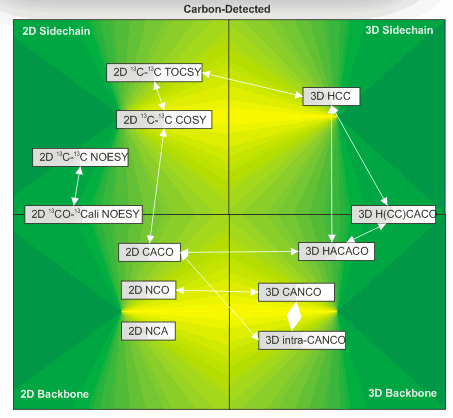Carbon-detected NMR Experiments
Pulse Program Catalogue
Carbon-detected NMR Experiments |
Go to Tutorials
Pulse Program Catalogue |
With the advent of high-sensitivity probeheads, 2D 13C-detected and 3D 13C-detected experiments have become attractive tools to be applied in special cases, as for instance, in large deuterated proteins or in paramagnetic proteins ( 04JACS10496 ) showing fast relaxing properties. For a complete revision article see 06PROG25-48 .
Advantages of 13C detection:
- Enables to work at a very high level of proton dilutions. Interesting for large deuterated proteins.
- Better resolution on the acquired dimension.
- The overall length of the pulse sequences can be shortened. Interesting for fast relaxing systems such as paramagnetic proteins or flexible proteins.
- The requirements for solvent suppression during acquisition are avoided.
- Improved sensitivity and resolution with the possible use of deconvolution using maximum Entropy (MaxEnt) resonstruction to eliminate the CC splitting in the final spectra.
- ACquisition can be started with anti-phase coherence, resulting in higher sensitivity due to the elimination of the final INEPT transfer step ( 04JB175-30 )
Disadvantages of 13C detection:
- The sensitivity of a NMR pulse scheme depends of gamma(exp(3/2)). Thus, in the case of 13C, proton-detection is 8 times more sensitive than 13C-detection.